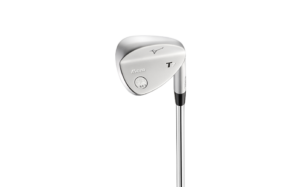 Make your wedge game more consistent. How, you ask? By having the correct lofts, bounces, lie angles, lengths and shafts. First, let’s start with the number of wedges you have in your bag. Most players have at least three: Pitching wedge, gap or approach wedge and sand wedge. Or, you may have a pitching wedge, sand wedge and lob wedge. Better players tend to have just three because they feel comfortable adjusting the face to get the desired distance from their wedges. Amateurs would be better off with four wedges so they can get more consistent distances with each of their wedges.
Make your wedge game more consistent. How, you ask? By having the correct lofts, bounces, lie angles, lengths and shafts. First, let’s start with the number of wedges you have in your bag. Most players have at least three: Pitching wedge, gap or approach wedge and sand wedge. Or, you may have a pitching wedge, sand wedge and lob wedge. Better players tend to have just three because they feel comfortable adjusting the face to get the desired distance from their wedges. Amateurs would be better off with four wedges so they can get more consistent distances with each of their wedges.
LOFTS: If you are playing a set of irons you purchased within the last five years, the loft on your PW (pitching wedge) will be somewhere between 44 and 46 degrees. If you do not have a GW or AW (gap wedge or approach wedge) in your set, the next wedge is a SW (sand wedge) which is typically 55 to 56 degrees of loft. This difference of 10 to 11 degrees of loft creates a big “gap” in distance, hence the need for a GW. A GW or AW will typically have a loft between 50 and 52 degrees. When we do a fitting, we make sure there is no more than 5 degrees of loft separation between the wedges. A typical four wedge set would be 45, 50, 55 and 60 degrees. This will create more consistent distances with your wedges so you will feel more confident stepping over a wedge shot from a particular distance.
LENGTH: If you purchase wedges off-the-rack, you will find that there is a lot of variation in lengths of wedges. For example, a standard men’s PW may be 35.75″, a GW 35.5″, SW at 35.25″ and LW at 35″. The reason manufacturer’s do this is to make the swing weight (measure of how heavy or light a club feels) more consistent. The only problem is that this length variation can create slightly more distance gaps between your wedges, or create inconsistent contact. We recommend that you have all of your wedges the same length, even if the SW and LW may play a little heavier in swing weight.
BOUNCE: There are several components to the “bounce” of golf clubs. The bounce angle is typically what is marked on clubs and is the angle between the ground and leading edge of the wedge. This typically runs from 4 to 14 degrees. In general, the tighter the lie, harder the sand, the lower the bounce so you don’t “bounce” off the ground or sand. Softer sand and deeper grass require more bounce. We have developed a wedge bounce guide to help you determine the appropriate bounce for you and the courses you play.
SHAFTS: We recently published a blog post about selecting the right wedge shafts. The short answer is to play the same weight and flex in your wedges as you do in your irons. This will give you much more consistency in distances and shot dispersion. Read more about it in the wedge shaft fitting post here.
By making sure you have the right number of wedges with the proper lofts, lengths and bounces, and a consistent set of shafts, your wedge play will improve and you will drop 1-2 strokes off your game!
Dan Sueltz
